全文HTML
--> --> -->度中心性法[4]认为节点拥有的邻居数越多, 其直接影响力越强. 对食物链网络[5]、P2P网络[6]、电子邮件网络[7]以及蛋白质网络[8]的研究指出, 当度值较大的节点被移除后, 网络结构将变得更加脆弱. 此外, 度中心性法计算简便, 其时间复杂度为






以上方法均存在各自的不足, 本研究将提出一种新的节点重要性评价方法, 即加权K-阶传播数法, 并试图利用WS (Watts-Strogatz)小世界网络、海豚网络、美国西部电网、芝加哥公路网络、网络科学家合著网络以及小鼠神经纤维束网络进行仿真分析, 以证明该方法的有效性.
首先给定无向网络图



















































1)已感染者会向其相邻的所有易感染者传播疾病;
2)已感染者向其相邻的易感染者传播疾病的耗时相等, 并设为1;
3)易感染者一旦受到其任一相邻的已感染者的传播, 便转化为已感染者.
在衡量节点的重要性时, 较为常用的方法是分别将各个节点设置为传染源进行疾病传播, 并以网络中所有节点被转化为已感染者的总耗时作为节点重要性的评价指标, 总耗时越少, 则证明节点越重要. 然而, 当网络非连通时, 从不同节点出发最终能够传播到的节点总数未必相同. 为了保证一致性, 另一种节点重要性衡量方法仍是将各个节点设置为传染源, 但比较的是在经历相同的传播时长K后网络中已感染者的数量, 数量越大则证明该节点越重要. 基于假设2可将传播时长K取值离散, 并规定为非负整数, 这与SI等模型中时间取值连续的假设略有不同. 其中, 当

此外, 基于假设1和3可以得到以













传播时长K的取值是影响节点重要性评价结果的关键. 文献[24]利用



























2
3.1.WS小世界网络
小世界网络是指同时具有较短特征路径长度以及较大平均聚类系数的一种网络类型. Watts和Strogatz[25]最早提出了一种构造小世界网络的方法, 即将最近邻耦合网络中的边依概率进行随机重连, 通常将这种网络称为WS小世界网络. 图1(a)基于100节点最近邻耦合网络随机生成了一个WS小世界网络, 该最近邻耦合网络中每个节点与其邻近的左右两侧各两个节点相连. 在随机重连后, 边31-33和95-96分别被改连为31-72和95-53, 见图1(b)和图1(c), 其余边的位置不变. 图 1 随机生成的100节点WS小世界网络 (a) 网络结构; (b) 边31-33被改连至边31-72; (c) 边95-96被改连至边95-53
图 1 随机生成的100节点WS小世界网络 (a) 网络结构; (b) 边31-33被改连至边31-72; (c) 边95-96被改连至边95-53Figure1. A random WS small-world network with 100 nodes: (a) Network structure; (b) the edge 31-33 is rescheduled to the edge 31-72; (c) the edge 95-96 is rescheduled to the edge 95-53.
表1列出了该WS小世界网络与同规模随机网络的平均聚类系数、特征路径长度等参数. 可见, 该网络的特征路径长度为随机网络的2.49倍, 但其平均聚类系数为随机网络的近20倍, 这是由于边31-72和95-53的长程连接提高了网络的连通性.
| 网络类型 | 节点数 | 边数 | 平均聚类 系数 | 特征路径 长度 |
| WS小世界网络 | 100 | 200 | 0.486 | 8.4891 |
| 随机网络 | 100 | 200 | 0.0254 | 3.4158 |
表1WS小世界网络以及同规模随机网络的网络参数
Table1.Network features of the WS small-world network and random networks.
现利用加权K-阶传播数法对该网络节点的重要性进行分析. 图2(a)为网络的K-阶结构熵


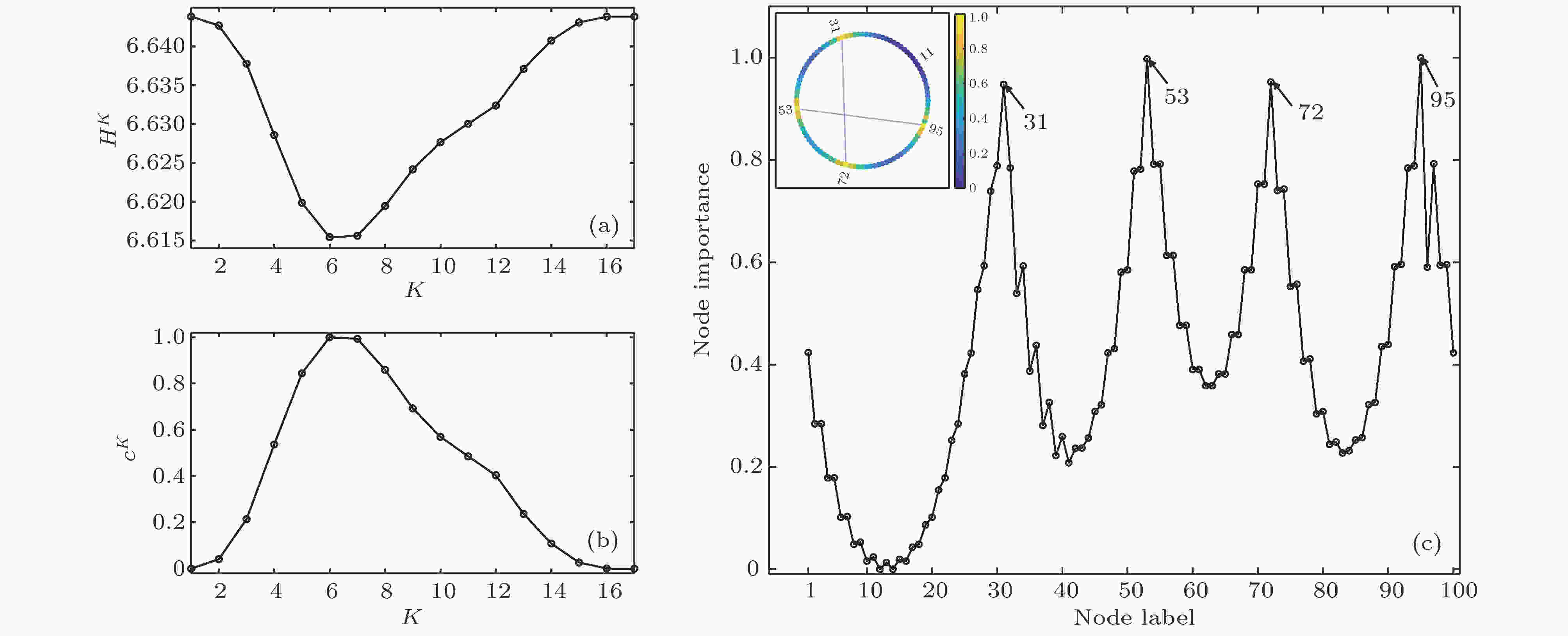 图 2 基于加权K-阶传播数法的WS小世界网络节点重要性结果 (a) K-阶结构熵; (b) 权重系数; (c) 节点重要性
图 2 基于加权K-阶传播数法的WS小世界网络节点重要性结果 (a) K-阶结构熵; (b) 权重系数; (c) 节点重要性Figure2. Node importance of the WS small-world network based on the weighted K-order propagation number algorithm: (a) The K-order structure entropy; (b) the weight coefficient; (c) the importance of nodes.
由前文所述, 节点95和53, 31和72之间的长程连接提高了网络的连通性, 若移除上述任一节点, 网络的特征路径长度将大为增加, 因此加权K-阶传播数法认为以上四个节点的重要性最高是较为合理的. 由于该网络是基于最近邻耦合网络构造的, 而最近邻耦合网络中每个节点与其邻近的左右两侧各两个节点相连. 因此, 与95, 53, 31, 72距离相近的左右各两个节点的重要性应当相似, 且距离95, 53, 31, 72越远, 节点的重要性越低. 例如, 移除91, 92, 99或98中的任一节点对网络结构造成的影响是相似的; 此外, 同时移除99和98相较同时移除100和1, 会有更多的节点难以通过95进行长程通信, 因此99和98的重要性高于100和1是较为合理的. 值得注意的是, 图2(c)中97的重要性显著高于96, 这是由于边96-95被断开, 若依赖96进行长程通信需要借助边95-94, 而97与95直接相连, 因此通过97进行长程通信更为便捷. 此外, 由于边33-31被断开, 33, 34, 35等节点向30, 29, 28等节点进行短程通信, 或经由31向72等节点进行长程通信, 均需要依赖节点32, 因此其重要性应当较高. 最后, 35, 36, 37, 38等节点进行长短程通信时需要依赖33或34; 对35, 37等奇数节点而言, 通过33或34进行通信的效果相同, 但对36, 38等偶数节点而言, 通过34进行通信的效率更高, 可见34的重要性大于33, 这也可以解释图2(c)中36的重要性略高于35等现象.
为了进一步证明加权K-阶传播数法的有效性, 图3绘制了度中心性、Ren法、Chen法、介数中心性、特征向量法、Katz指标(权重衰减因子取1.5倍邻接矩阵最大特征值的倒数)、PageRank算法(阻尼系数取0.85)以及CI法(权重系数取0.5)得出的节点重要性结果. 由于K-核分解法得到的所有节点的重要性相同, 因此其结果未在图3给出.
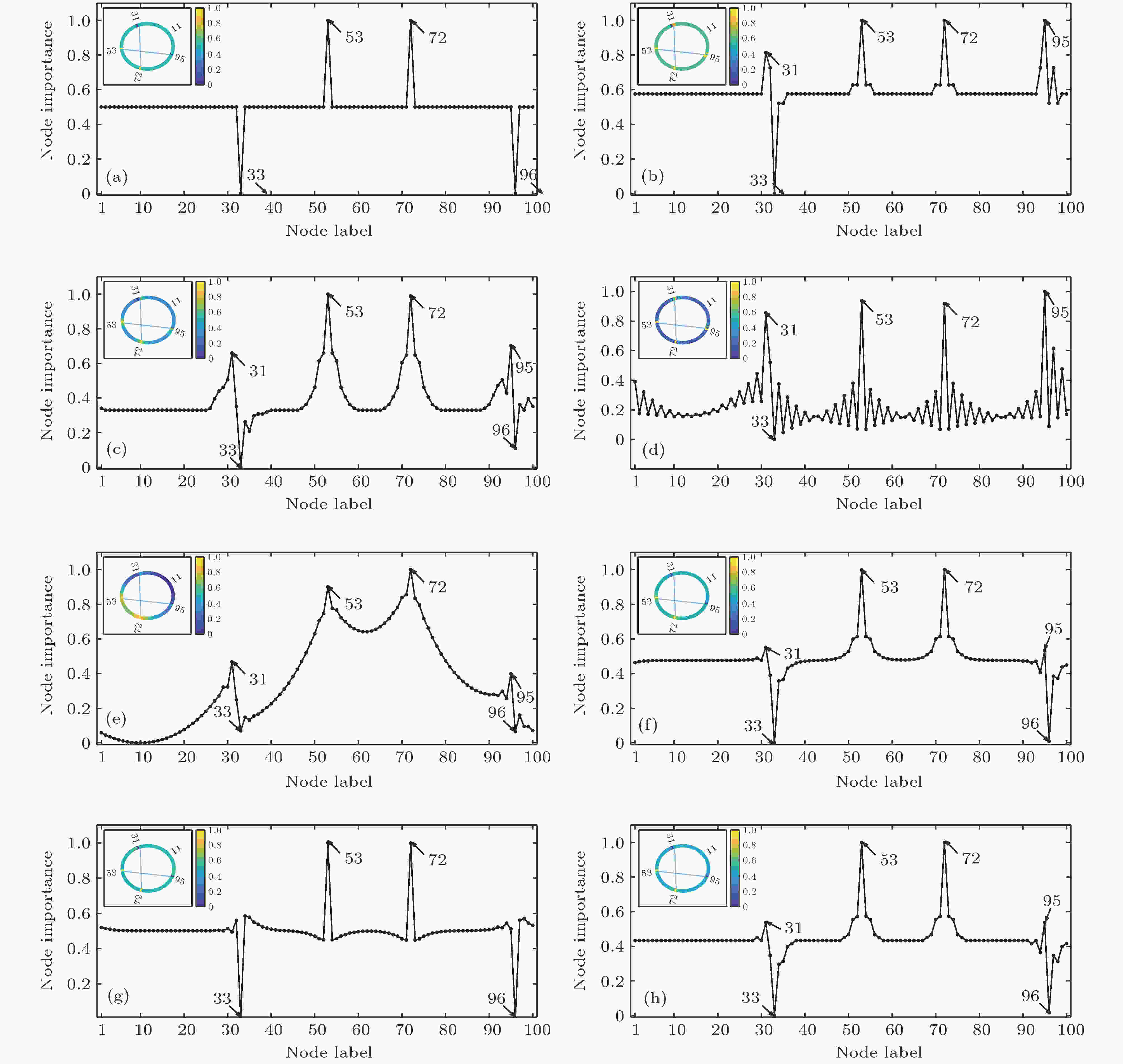 图 3 基于若干传统算法的WS小世界网络节点重要性评价结果 (a) 度中心性; (b) Ren法; (c) Chen法; (d) 介数中心性; (e) 特征向量法; (f) Katz指标法; (g) PageRank算法; (h) CI法
图 3 基于若干传统算法的WS小世界网络节点重要性评价结果 (a) 度中心性; (b) Ren法; (c) Chen法; (d) 介数中心性; (e) 特征向量法; (f) Katz指标法; (g) PageRank算法; (h) CI法Figure3. Node importance of the WS small-world network based on some traditional algorithms: (a) Degree centrality; (b) Ren method; (c) Chen method; (d) betweenness centrality; (e) eigenvector method; (f) Katz index; (g) PageRank; (h) CI method.
由图3可知, 以上方法认为33或96的重要性最低, 而加权K-阶传播数法却认为33和96的重要性较高. 由前文分析可知, 虽然在33节点移除后, 网络的长短程通信不会受到显著影响, 但27, 28, 29等节点与34, 35, 36等节点间的短程通信, 或34, 35, 36等节点依靠31进行长程通信只能依赖边32-34进行; 同样, 当96被移除后, 边95-97将参与所有通信, 可见33和96的存在降低了其余重要节点或边的负载, 起到了分流的作用, 因此认为33或96在所有节点中重要性最低是值得商榷的; 度中心性、特征向量法、Katz指标、PageRank算法和CI法认为72和53的重要性远高于31和95, 但长程通信需要同时依赖以上4个节点进行, 因此节点31和72或95和53的重要性应当是相似的; 度中心性、Ren法、Chen法、Katz指标、PageRank算法和CI法, 尤其是K-核分解法对节点的排序并不细致, 存在节点重要性相同的情况; 此外, 介数中心性认为10, 11, 12等节点的重要性高于52, 54, 71, 73等节点, 49, 51, 55, 57, 74, 76等节点的重要性高于50, 52, 54, 56, 73, 75等节点, PageRank算法认为61, 62, 63等节点的重要性高于52, 54, 71, 73等节点, 均缺乏较为合理的解释. 可见, 加权K-阶传播数法对网络通信的刻画更为细致, 节点重要性的评估优于以上传统方法.
2
3.2.海豚网络
为了进一步验证加权K-阶传播数法的有效性, 本文以海豚网络为例进行研究. Lusseau等[26,27]对新西兰道特富尔峡湾(Doubtful Sound) 62只宽吻海豚进行研究并构建了海豚社会网络. 基于加权K-阶传播数法的海豚网络节点重要性结果如图4所示, 图4(a)为网络的K-阶结构熵

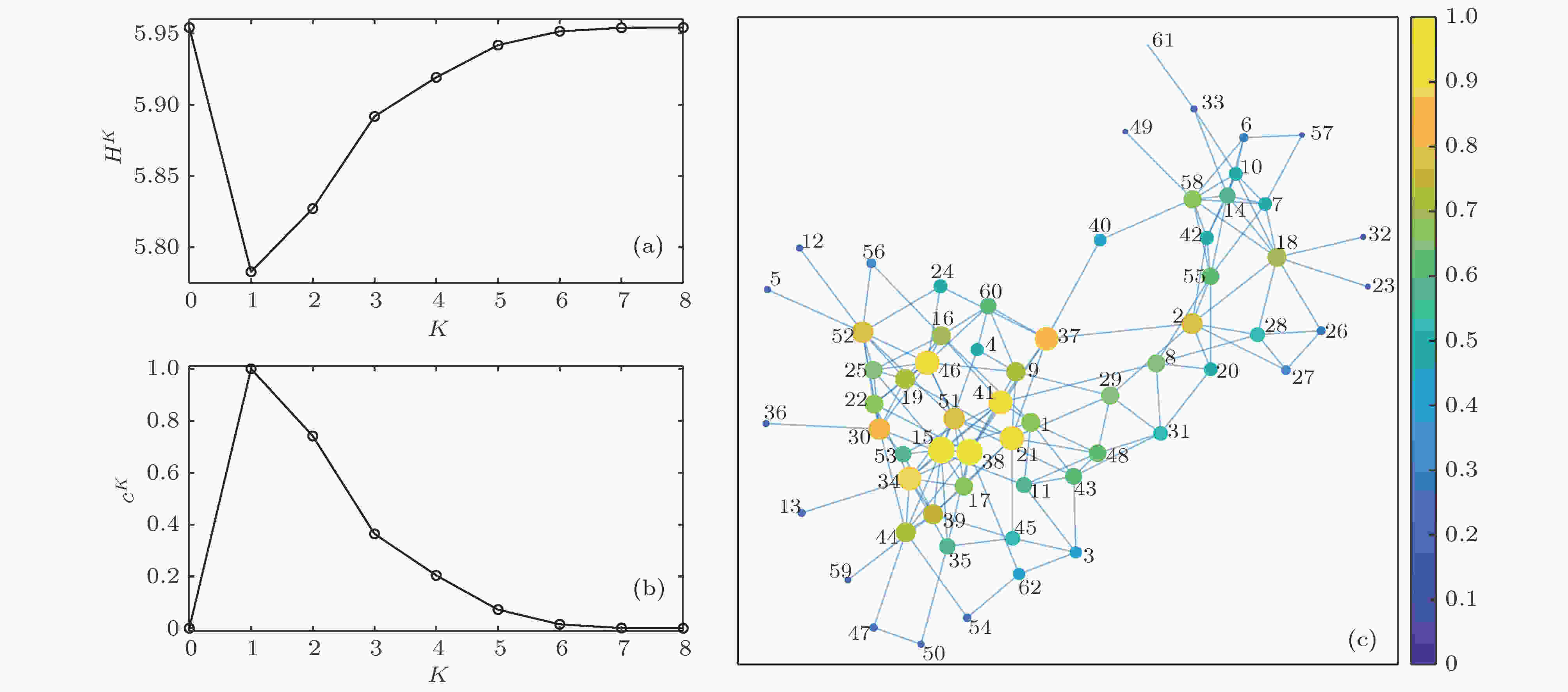 图 4 基于加权K-阶传播数法的海豚网络节点重要性结果 (a) K-阶结构熵; (b) 权重系数; (c) 节点重要性
图 4 基于加权K-阶传播数法的海豚网络节点重要性结果 (a) K-阶结构熵; (b) 权重系数; (c) 节点重要性Figure4. Node importance of the dolphin network based on the weighted K-order propagation number algorithm: (a) The K-order structure entropy; (b) the weight coefficient; (c) the importance of nodes.
表2列出了基于加权K-阶传播数法、Ren法、Chen法、介数中心性、特征向量法、Katz指标(权重衰减因子为1.5倍邻接矩阵最大特征值的倒数)、PageRank算法(阻尼系数0.85)、CI法(权重系数取0.5)得出的前15个重要节点的排序结果. 由于度中心性和K-核分解法存在节点重要性相等的情况, 其排序结果未在表2列出. 其中, 基于度中心性法得到的节点重要性排序结果(前20个重要节点)为15 > 38 = 46 > 34 = 52 > 18 = 21 = 30 = 58 > 2 = 14 = 39 = 41 > 10 = 16 = 19 = 37 = 44 = 51 = 55; K-核分解法认为1, 2, 7, 8, 9等37个节点的重要性最高且相等.
| 节点重要性 | 加权K-阶传播数法 | Ren法 | Chen法 | 介数中心性法 | 特征向量法 | Katz指标法 | PageRank算法 | CI法 |
| 1 | 15 | 15 | 15 | 37 | 15 | 15 | 15 | 15 |
| 2 | 38 | 38 | 38 | 2 | 38 | 38 | 18 | 38 |
| 3 | 46 | 46 | 46 | 41 | 46 | 46 | 52 | 46 |
| 4 | 21 | 34 | 34 | 38 | 34 | 34 | 58 | 34 |
| 5 | 41 | 51 | 51 | 8 | 51 | 52 | 38 | 41 |
| 6 | 34 | 41 | 41 | 18 | 30 | 30 | 46 | 30 |
| 7 | 37 | 21 | 17 | 21 | 52 | 41 | 34 | 52 |
| 8 | 30 | 30 | 22 | 55 | 17 | 21 | 30 | 21 |
| 9 | 52 | 52 | 19 | 52 | 41 | 51 | 14 | 51 |
| 10 | 51 | 44 | 30 | 58 | 22 | 39 | 2 | 19 |
| 11 | 2 | 39 | 21 | 40 | 19 | 19 | 21 | 39 |
| 12 | 39 | 19 | 25 | 29 | 39 | 17 | 39 | 17 |
| 13 | 19 | 37 | 39 | 30 | 25 | 22 | 10 | 22 |
| 14 | 44 | 22 | 52 | 44 | 44 | 44 | 41 | 44 |
| 15 | 9 | 18 | 44 | 15 | 21 | 25 | 55 | 25 |
表2海豚网节点重要性排序结果
Table2.Node importance ordering result of the dolphin network.
与度中心性、Ren法、Chen法、特征向量法、Katz指标、PageRank算法和CI法不同, 加权K-阶传播数法认为节点37相对重要, 排在第7位. 文献[27]将该海豚网络划分成了若干小社区, 指出37号海豚曾消失了一段时间, 此时不同海豚社区间的互动受到了限制, 当37号海豚再次出现时, 社区又恢复了普遍联系, Lusseau等[27]指出37号海豚是社区间信息交流的关键个体. 因此, 加权K-阶传播数法认为节点37相对重要的结论是较为合理的. 然而, 37号海豚处于社区边缘, 因此介数中心性认为节点37重要性最高的结论是值得商榷的.
此外, 加权K-阶传播数法提高了对节点2和21的重视程度, 分别排在第11和第4位, 而2和21处于各自海豚社区偏中心位置, 又与37等负责信息交流的节点直接相连, 因此该结论是较为合理的; Ren法、Chen法、特征向量法、Katz指标法和CI法认为节点22相对重要, 但该节点的度中心性与介数均是较低的; 最后, 度中心性法和K-核分解法存在节点重要性相同的情况, 排序不细致. 可见, 加权K-阶传播数法在评价海豚网络节点重要性时适当地提高了对海豚社区间信息交流起到关键作用的节点的重视程度, 结果更为合理.
2
3.3.基于节点重要性的蓄意攻击研究
为了进一步验证加权K-阶传播数法的优越性, 本文对美国西部电网[25]、芝加哥公路网络[28]、网络科学家合著网络[29]以及小鼠神经纤维束网络(Kasthuri_graph_v4)[30]进行了节点重要性研究. 其中美国西部电网共有4941个节点和6594条边, 描述了美国西部的高压输电电网结构; 芝加哥公路网络共有1467个节点和1298条边, 描述了美国芝加哥地区的公路运输情况; 网络科学家合著网络共有1589个节点和2742条边, 描述了从事网络理论和实验的科学家合著关系; 小鼠神经纤维束网络共有1029个节点和1700条边, 描述了小鼠部分脑皮层中神经元间的轴突束连接. 美国西部电网、芝加哥公路网络和网络科学家合著网络均是无权无向的; 小鼠神经纤维束网络是有权无向的, 为了适应加权K-阶传播数法, 本文忽略了该网络的边权信息. 以上网络的K-阶结构熵HK如图5所示.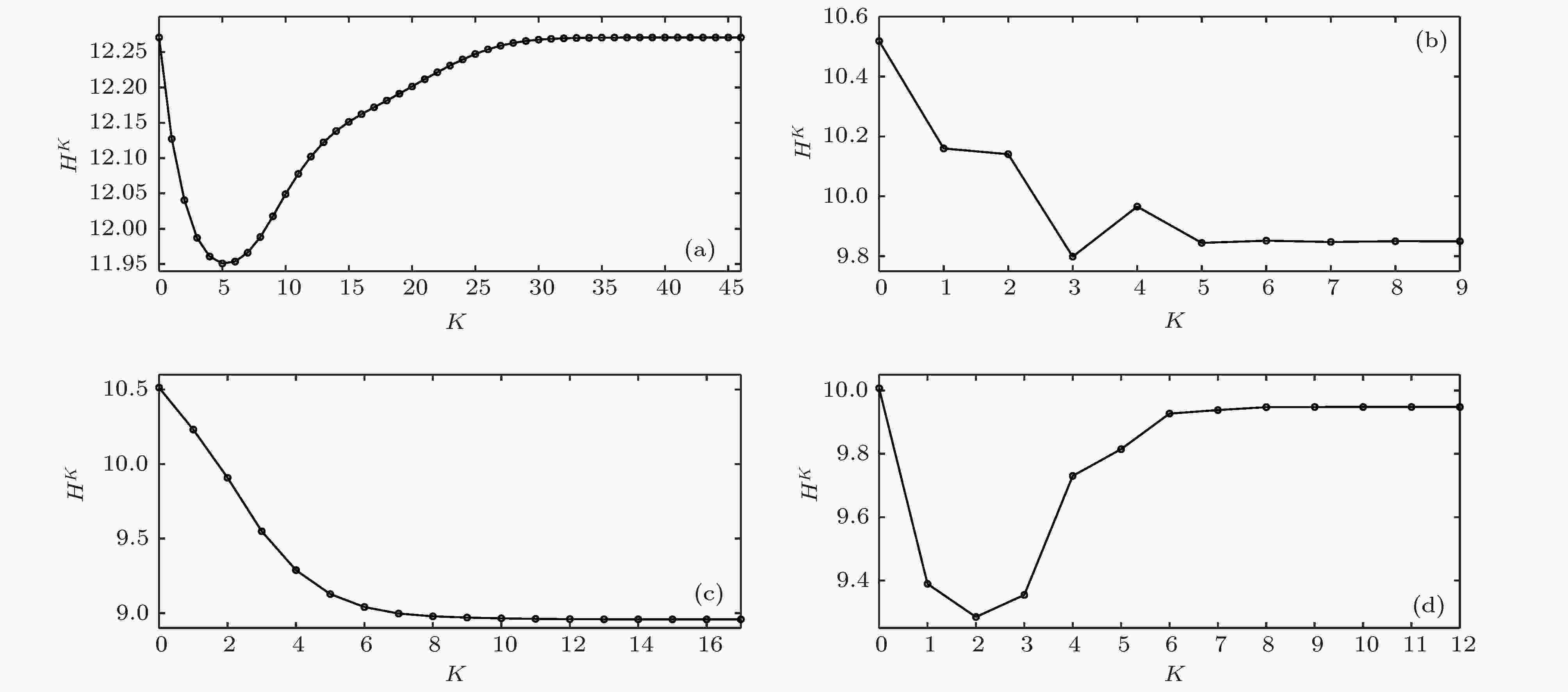 图 5 K-阶结构熵 (a) 美国西部电网; (b) 芝加哥公路网络; (c) 科学家合作网络; (d) 小鼠神经纤维束网络
图 5 K-阶结构熵 (a) 美国西部电网; (b) 芝加哥公路网络; (c) 科学家合作网络; (d) 小鼠神经纤维束网络Figure5. The K-order structure entropy: (a) The western power grid of the United States; (b) the road transportation network of the Chicago region; (c) the co-authorship network in network science; (d) the axonal tracts network between neurons of mouse.
由于以上四个网络的节点数较多, 本文拟采用蓄意攻击策略对节点重要性进行研究[31-33]. 蓄意攻击策略是指基于节点重要性由高到低的排序依次攻击网络, 即移除与节点相连的所有边, 通过网络结构随攻击次数的变化情况来评价节点重要性算法的各自特点. 由于在蓄意攻击后网络结构发生了变化, 因此仅仅依据原始网络的节点重要性进行研究会存在偏差. 为了解决此问题, 本文在每次蓄意攻击后更新节点排序结果. 此外, 若存在重要性相等的情况, 将选择编号最小的节点进行攻击.
由于网络被攻击后可能会出现孤立节点, 因此选用网络效率来评价网络的连通性. 网络效率的表达式为









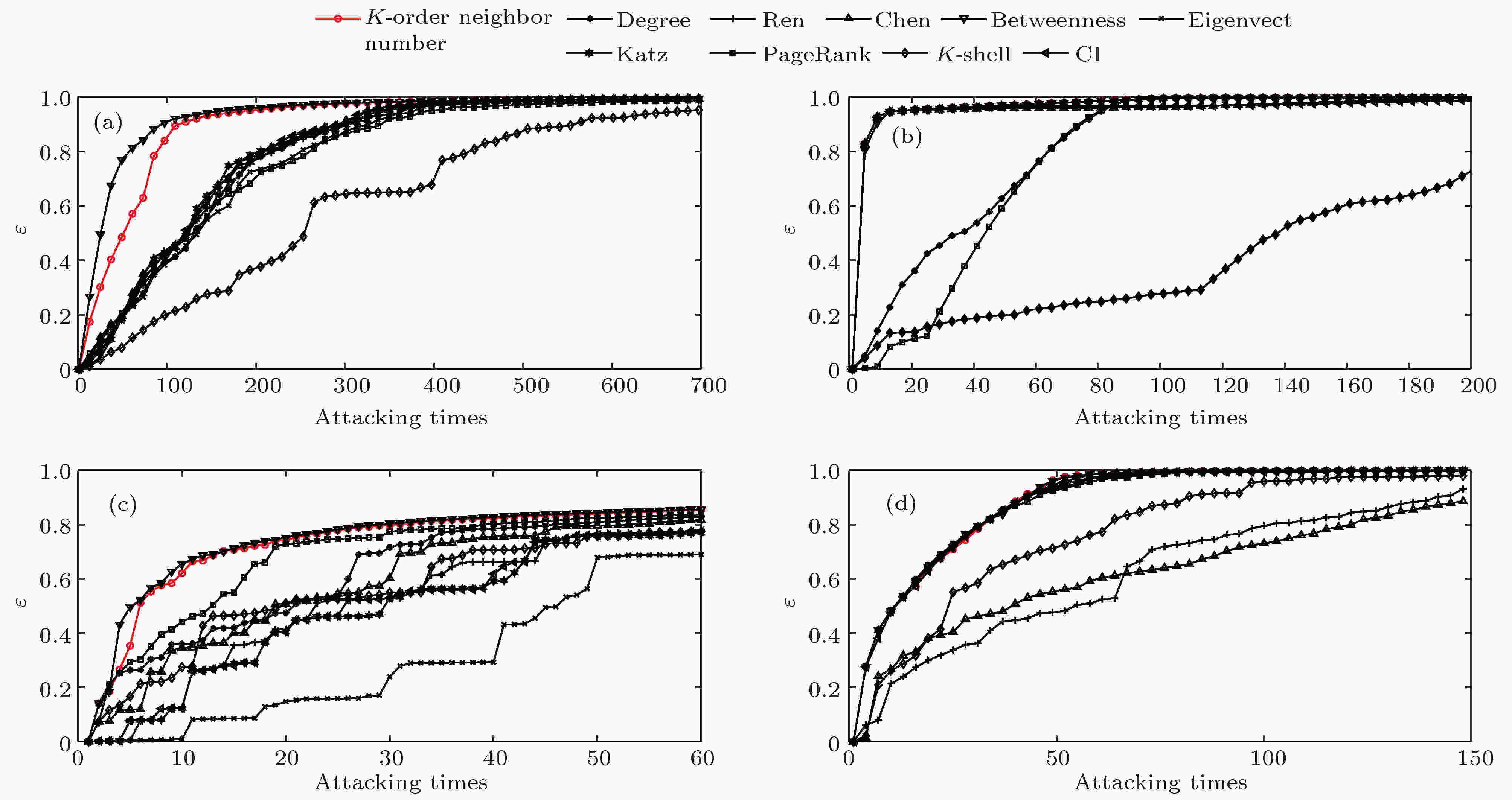 图 6 网络效率下降率ε随攻击次数的变化情况 (a) 美国西部电网; (b) 芝加哥公路网络; (c) 网络科学家合著网络; (d) 小鼠神经纤维束网络
图 6 网络效率下降率ε随攻击次数的变化情况 (a) 美国西部电网; (b) 芝加哥公路网络; (c) 网络科学家合著网络; (d) 小鼠神经纤维束网络Figure6. Change of the network efficiency decrease rate ε with attacking times: (a) The western power grid of the United States; (b) the road transportation network of the Chicago region; (c) the co-authorship network in network science; (d) the axonal tracts network between neurons of mouse.
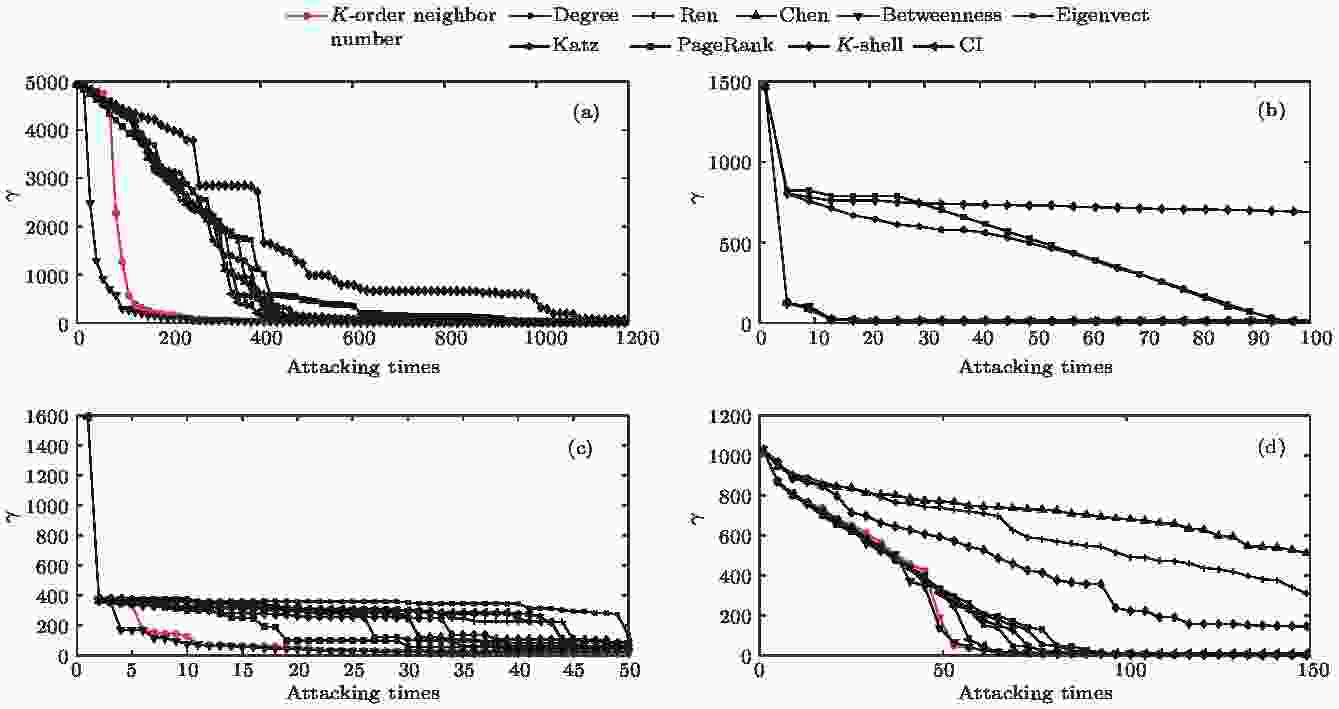 图 7 最大子图节点数γ随攻击次数的变化情况 (a) 美国西部电网; (b) 芝加哥公路网络; (c) 网络科学家合著网络; (d) 小鼠神经纤维束网络
图 7 最大子图节点数γ随攻击次数的变化情况 (a) 美国西部电网; (b) 芝加哥公路网络; (c) 网络科学家合著网络; (d) 小鼠神经纤维束网络Figure7. Change of the node number of the maximum sub-graph ε with attacking times: (a) The western power grid of the United States; (b) the road transportation network of the Chicago region; (c) the co-authorship network in network science; (d) the axonal tracts network between neurons of mouse.
对美国西部电网而言, 依照加权K-阶传播数法和介数中心性法的排序结果进行攻击, 网络效率下降得最为迅速, 仅攻击约100次后, 网络效率便下降了近90%; 而依据度中心性、Ren法、Chen法、特征向量法、Katz指标、PageRank算法和CI法则需约300次, K-核分解法需约550次, 才能达到同等效果. 此外, 基于加权K-阶传播数法和介数中心性对网络进行攻击, 最大子图节点数降低的速率远远高于其他方法. 以加权K-阶传播数法为例, 当网络被攻击200次后, 最大子图节点数仅为154, 为原始网络节点数的3%, 可认为网络基本瘫痪. 而度中心性、Ren法、Chen法、特征向量法、Katz指标和CI法则需攻击近400次, PageRank算法需650次, K-核分解法需1000次才能达到相同效果; 对芝加哥公路网络而言, 依据加权K-阶传播数法、介数中心性、Chen法、特征向量法、Katz指标和CI法进行蓄意攻击, 网络被破坏的程度较为接近, 且优于度中心性、Ren法、PageRank算法和K-核分解法. 其中, 依据加权K-阶传播数法进行蓄意攻击, 网络效率下降得最为迅速; 对网络科学家合著网络而言, 依照加权K-阶传播数法和介数中心性进行蓄意攻击, 网络被破坏的程度较为接近, 且优于其他算法; 对小鼠神经纤维束网络而言, 依据加权K-阶传播数法、度中心性、介数中心性、特征向量法、Katz指标、PageRank算法和CI法进行蓄意攻击, 网络被破坏的程度较为接近, 且优于Ren法、Chen法和K-核分解法. 其中, 依据加权K-阶传播数法和介数中心性进行蓄意攻击, 网络最大子图节点数下降得最为迅速, 略优于其他算法.
综上所述, 无论对美国西部电网、芝加哥公路网络、网络科学家合著网络还是小鼠神经纤维束网络而言, 基于加权K-阶传播数法进行蓄意攻击, 仅需移除少量重要节点便可实现对网络结构的充分破坏.
